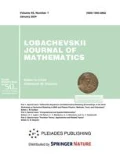Abstract
The described project is aimed at a complete solution to the problem of joint analysis of the properties of algorithms and features with the architecture of computing systems. This problem arose in the mid-70s of the last century, and over time, its importance in the practice of using computer systems is constantly growing. The main reason is a significant complication of the architecture of computers, which determines a strong dependence of the efficiency of their work on the properties of algorithms and programs. Exactly this dependence leads in practice to a huge gap between real and peak performance indicators, which is typical for all classes of computers from mobile devices to supercomputers of the highest performance range. It is this dependence that leads to a decrease in the quality of work of supercomputer centers and a drop in the efficiency of computer systems below a fraction of a percent. And at the same time, the fundamental nature of the problem itself determines two important facts. First, it is characteristic of all computer systems and centers of the world without exception. Second, practically all scientific groups of the world in all science areas conducting research using high-performance computing systems face this problem.



Similar content being viewed by others
REFERENCES
Scientific and Educational Internet Resource of the Research Computing Center of Moscow State University for Numerical Analysis. http://num-anal.srcc.msu.ru/. Accessed 2020.
W. H. Press, S. A. Teukolsky, W. T. Vetterling, B. P. Flannery, and M. Metcalf, Numerical Recipes in C: The Art of Scientific Computing, 2nd ed. (Cambridge Univ. Press, Cambridge, 1992).
R. Barrett, M. Berry, T. F. Chan, J. Demmel, J. Donato, J. Dongarra, V. Eijkhout, R. Pozo, C. Romine, and H. van der Vorst, Templates for the Solution of Linear Systems: Building Blocks for Iterative Methods (Cambridge Univ. Press, Cambridge, 1992).
Wikipedia. List of Algorithms. https://en.wikipedia.org/wiki/List_of_algorithms. Accessed 2020.
ALGLIB. https://www.alglib.net/. Accessed 2020.
A Library of Parallel Algorithms. https://www.cs.cmu.edu/ scandal/nesl/algorithms.html. Accessed 2020.
K. Asanovic, R. Bodik, B. C. Catanzaro, et al., ‘‘The landscape of parallel computing research: A view from Berkeley,’’ Report UCB/EECS–2006–183 (Univ. California, Berkeley, 2006). https://www2.eecs.berkeley.edu/Pubs/TechRpts/2006/EECS-2006-183.pdf. Accessed 2020.
D. Knuth, The Art of Computer Programming, 3rd ed. (Addison-Wesley, Reading, MA, 2011), Vols. 1–4A.
J. M. Ortega, Introduction to Parallel and Vector Solution of Linear Systems (Plenum, New York, 1988).
Y. Saad, Iterative Methods for Sparse Linear Systems, 2nd ed. (Soc. Ind. Appl. Math., Philadelphia, 2003).
Open Encyclopedia of Parallel Algorithmic Features. https://algowiki-project.org. Accessed 2020.
TOP500 Supercomputer Sites. https://www.top500.org/. Accessed 2020.
Graph 500. http://graph500.org/. Accessed 2020.
HPCG Benchmark. http://hpcg-benchmark.org/. Accessed 2020.
S. S. Dosanjh, R. F. Barrett, D. W. Doerfler, S. D. Hammond, et al., ‘‘Exascale design space exploration and co-design,’’ Future Generat.Comput. Syst. 30, 46–58 (2014).
D. E. Shaw et al., ‘‘Anton2: Raising the bar for performance and programmability in a special-purpose molecular dynamics supercomputer,’’ in Proceedings of the SC14 International Conference on High Performance Comput. Networking, Storage Analysis (IEEE Press, Piscataway, 2014), pp. 41–53.
Co-Design Centers. https://www.exascaleproject.org/topics/co-design-centers/. Accessed 2020.
V. Voevodin, A. Antonov, and J. Dongarra, ‘‘AlgoWiki: An open encyclopedia of parallel algorithmic features,’’ Supercomput. Front. Innov. 1 (2), 4–18 (2015). https://doi.org/10.14529/jsfi150101
V. V. Voevodin and Vl. V. Voevodin, Parallel Computing (BHV-Petersburg, St. Petersburg, 2002) [in Russian].
A. S. Antonov and N. I. Volkov, ‘‘An web-visualization system for the AlgoWiki project,’’ Commun. Comput. Inform. Sci. 753, 3–13 (2017). https://doi.org/10.1007/978-3-319-67035-5_1
A. Antonov and N. Volkov, ‘‘Interactive 3D representation as a method of investigating information graph features,’’ Commun. Comput. Inform. Sci. 965, 587–598 (2018). https://doi.org/10.1007/978-3-030-05807-4_50
A. Antonov, A. Frolov, H. Kobayashi, I. Konshin, A. Teplov, Vad. Voevodin, and Vl. Voevodin, ‘‘Parallel processing model for Cholesky decomposition algorithm in AlgoWiki project,’’ Supercomput. Front. Innov. 3 (3), 61–70 (2016). https://doi.org/10.14529/jsfi160307
I. Afanasyev, A. Antonov, D. Nikitenko, Vad. Voevodin, V. Voevodin, K. Komatsu, O. Watanabe, A. Musa, and H. Kobayashi, ‘‘Developing efficient implementations of Bellman-Ford and forward-backward graph algorithms for NEC SX-ACE,’’ Supercomput. Front. Innov. 5 (3), 65–69 (2019). https://doi.org/10.14529/jsfi180311
A. Antonov, A. Frolov, I. Konshin, and Vl. Voevodin, ‘‘Hierarchical domain representation in the AlgoWiki encyclopedia: From problems to implementations,’’ Commun. Comput. Inform. Sci. 910, 3–15 (2018). https://doi.org/10.1007/978-3-319-99673-8_1
D. Nikitenko, Vad. Voevodin, and S. Zhumatiy, ‘‘Driving a petascale HPC center with octoshell management system,’’ Lobachevskii J. Math. 40 (11), 1817–1830 (2019). https://doi.org/10.1134/S1995080219110192
D. Nikitenko and A. Zheltkov, ‘‘The Top50 list vivification in the evolution of HPC rankings,’’ Commun. Comput. Inform. Sci. 753, 14–26 (2017). https://doi.org/10.1007/978-3-319-67035-5_2
V. Voevodin, A. Antonov, D. Nikitenko, P. Shvets, S. Sobolev, I. Sidorov, K. Stefanov, V. Voevodin, and S. Zhumatiy, ‘‘Supercomputer Lomonosov-2: Large scale, deep monitoring and fine analytics for the user community,’’ Supercomput. Front. Innov. 6 (2), 4–11 (2019). https://doi.org/10.14529/jsfi190201
Funding
The results were obtained in Lomonosov Moscow State University with the financial support of the Russian Science Foundation (agreement no. 20-11-20194). The research is carried out using the equipment of the shared research facilities of HPC computing resources at Lomonosov Moscow State University [27].
Author information
Authors and Affiliations
Corresponding authors
Additional information
(Submitted by E. E. Tyrtyshnikov)
Rights and permissions
About this article
Cite this article
Antonov, A.S., Nikitenko, D.A. & Voevodin, V.V. Algo500—A New Approach to the Joint Analysis of Algorithms and Computers. Lobachevskii J Math 41, 1435–1443 (2020). https://doi.org/10.1134/S1995080220080041
Received:
Revised:
Accepted:
Published:
Issue Date:
DOI: https://doi.org/10.1134/S1995080220080041




